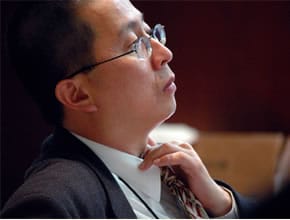Thanks to a bombshell investigation reported over the weekend by The New York Times, The Guardian, Inside Climate News and more, we now know that the prominent climate denialist Willie Soon, oft-cited by climate denying politicians and industry figures, calls his publications “deliverables” to his fossil fuel funders.
Some of these “deliverables” have even found their way into the reports produced by the Intergovernmental Panel on Climate Change (IPCC), generally regarded as the most comprehensive evaluation of the current state of climate science.
After years of research and information requests, The Climate Investigations Center and Greenpeace have unearthed incontrovertible proof that Soon, of the Harvard Smithsonian Center for Astrophysics (CfA), has received more than $1.2 million from the fossil fuel industry, and referenced many of his papers as “deliverables” in emails to funders.
According to the Times, at least 11 of the papers Soon has published since 2008 fail to disclose the fossil fuel industry funding. [Read Inside Climate News’ breakdown, “11 Times Willie Soon Failed to Disclose Fossil Funding.”]
Even more troubling, Soon’s industry-funded research has also turned up in the IPCC’s vital work. DeSmogBlog has searched all five of the IPCC’s major assessment reports for references to research and papers by Soon.
In all, seven papers that Soon co-authored have been referenced and/or cited in IPCC assessment reports. Two of the seven were papers referred to by Soon as “deliverables” in the correspondences just made public by Climate Investigations Center and Greenpeace. Some of the papers acknowledge research funding from various arms of the fossil fuel industry. But others do not. Some of the papers cited by the IPCC predate the Harvard Smithsonian Center involvement, but Soon’s long history of taking fossil fuel industry money is well established. In fact, as far back as 2003, years before the release of the Fourth Assessment Report (AR4), documents revealed that Soon was actively working to “undermine” the report.
For the historical and academic record, here are all of the papers co-authored by Willie Soon that have been referenced or cited by the IPCC in its periodic assessment reports. Soon’s papers were cited in the third, fourth, and fifth installments.
1) Fifth Assessment Report (AR5)
Working Group One (WGI)
Chapter 5, page 462
In the text: “These simulations suggest that solar and volcanic forcing (Fan et al., 2009; Liu et al., 2009a
Citation: Liu, J., B. Wang, Q. Ding, X. Kuang, W. Soon, and E. Zorita, 2009a: Centennial variations of the global monsoon precipitation in the last millennium: results from ECHO-G model. J. Clim., 22, 2356–2371. (PDF) Comment: This is one of the papers that Soon referred to as a “deliverable” to Southern Company funders, though Soon himself does not disclose any funding in the paper. According to DeSmogBlog contributor Dr. John Mashey, this appears to be “one of those innocuous papers that Soon and Baliunas have done to generate publications and credibility.” Note: Three different papers co-authored by Soon, including one “reply to responses” to a 2007 paper, are all referenced in the same sentence in Working Group Two’s portion of IPCC‘s Fifth Assessment Report. They are as follows.
2) Fifth Assessment Report (AR5) In the text: “Use of terrestrial resources by polar bears was suggested as adaptive (Dyck et al., 2007, 2008; Dyck and Romberg, 2007; Armstrong et al., 2008
Citation: Armstrong, J.S., K.C. Green, and W. Soon, 2008: Polar bear population forecasts: a public-policy forecasting audit. Interfaces, 38(5), 382-395. (PDF) Comment: No funding acknowledgement or disclosure from Soon or co-authors, though this is another paper that Soon referrered to as a “deliverable” in a report to his funders at Southern Company.
3) Fifth Assessment Report (AR5) In the text: “Use of terrestrial resources by polar bears was suggested as adaptive (Dyck et al., 2007, 2008; Dyck and Romberg, 2007; Armstrong et al., 2008; Dyck and Kebreab, 2009; Rockwell and Gormezano, 2009; Smith et al., 2010).” Citation: Dyck, M.G., W. Soon, R.K. Baydack, D.R. Legates, S. Baliunas, T.F. Ball, and L.O. Hancock, 2007: Polar bears of western Hudson Bay and climate change: are warming spring air temperatures the “ultimate” survival control factor? Ecological Complexity, 4(3), 73-84. (PDF) Comment: Fossil fuel industry funding of research is acknowledged: “M. Dyck and W. Soon initiated this scientific study around 2002–2003 without seeking research fundings and both have contributed equally. W. Soon’s effort for the completion of this paper was partially supported by grants from the Charles G. Koch Charitable Foundation, American Petroleum Institute, and Exxon-Mobil Corporation.”
4) Fifth Assessment Report (AR5) In the text: “Use of terrestrial resources by polar bears was suggested as adaptive (Dyck et al., 2007, 2008
Citation: Dyck, M.G., W. Soon, R.K. Baydack, D.R. Legates, S. Baliunas, T.F. Ball, and L.O. Hancock, 2008: Reply to response to Dyck et al. (2007) on polar bears and climate change in western Hudson Bay by Stirling et al. (2008). Ecological Complexity, 5(4), 289-302. (PDF) Comment: This is a reply to responses to the paper cited above (Dyck, et al, 2007), published in the same journal. There is no funding acknowledgement or disclosure from Soon or co-authors.
5) Fourth Assessment Report (AR4) In the text: “The ‘hockey stick’ reconstruction of Mann et al. (1999) has been the subject of several critical studies. Soon and Baliunas (2003) challenged the conclusion that the 20th century was the warmest at a hemispheric average scale. They surveyed regionally diverse proxy climate data, noting evidence for relatively warm (or cold), or alternatively dry (or wet) conditions occurring at any time within pre-defi ned periods assumed to bracket the so-called ‘Medieval Warm Period’ (and ‘Little Ice Age’). Their qualitative approach precluded any quantitative summary of the evidence at precise times, limiting the value of their review as a basis for comparison of the relative magnitude of mean hemispheric 20th-century warmth (Mann and Jones, 2003; Osborn and Briffa, 2006). Box 6.4 provides more information on the ‘Medieval Warm Period’.” Citation: Soon, W., and S. Baliunas, 2003: Proxy climatic and environmental changes of the past 1000 years. Clim. Res., 23(2), 89–110. (PDF) Comment: This is the infamous case that lead to the resignation of multiple editors of the Climate Research journal in protest over a flawed peer review process that allowed publication of the paper. Funding from the American Petroleum Institute was acknowledged: “This work was supported by funds from the American Petroleum Institute (01-0000-4579), the Air Force Office of Scientific Research (Grant AF49620-02-1- 0194) and the National Aeronautics and Space Administration (Grant NAG5-7635)”
6) Third Assessment Report (TAR) In the text: “An alternative approach which has been used to reconstruct TSI (Reid, 1997; Soon et al., 1996) is to assume that time variations in global surface temperature are due to a combination of the effects of solar variability and enhanced greenhouse gas concentrations and to find that combination of these two forcings which best combine to simulate surface temperature measurements. However, these authors did not take natural climatic variability into account and a TSI series derived by such methods could not be used as an independent measure of radiative forcing of climate.” Citation: Soon,W.H., E.S. Posmentier, and S.L. Baliunas, 1996: Inference of solar irradiance variability from terrestrial temperature changes, 1880-1993: An astrophysical application of the Sun-climate connection. Astrophys. J., 472, 891-982. (PDF) Comments: Funding from fossil fuel industry is acknowledged: “This program was supported by the Electric Power Research Institute, Mobil Foundation, Inc., Texaco Foundation, Inc., Scholarly Studies Program, and Langley-Abbot Fund of the Smithsonian Institution, American Petroleum Institute, and Richard C. Lounsbery Foundation. This research was made possible by a collaborative agreement between the Carnegie Institution of Washington and the Mount Wilson Institute.
7) Second Assessment Report (SAR) In the text: “A recent paper by Zhang et al (1994) helps to bracket the range of variability observed in sun-like stars and hence the likely past and future variability of our Sun. They noted that empirical models based upon sunspots and faculae do not account for all irradiance variations observed over an activity cycle (see also NRC (1994)) and base their con-elation on an observed relationship between brightness and excess chromospheric emission, using the Ca II H and …” Citation: Zhang, Q., W.H. Soon, S.L. Baliunas, G.W. Lockwood, B.A. Skiff and R.R. Radick, 1994; A method of determining possible brightness variations of the Sun in past centuries from observations of solar-type stars. Astrophys. J., 427, L111–L114. (PDF) Comments: The authors acknowledge funding from the fossil fuel industry: “The work at Mount Wilson Observatory was supported by the Mobil Foundation, Inc., Electric Power Research Institute, Scholarly Studies Program, and Langley-Abbot fund of the Smithsonian Institution, American Petroleum Institute and Richard C. Lounsbery Foundation. The work at Lowell Observatory was supported by the Lowell Research Fund and the Air Force Geophysics Laboratory. This research was made possible by a colloborative agreement between the Carnegie Institution of Washington and the Mount Wilson Institute.” According to the IPCC (see Annex 2 of the IPCC principles document, page 17), the lead authorship team of any given assessment report section, “is required to critically assess information they would like to include from any source. Each chapter team should review the quality and validity of each source before incorporating information into an IPCC Report.” If authors of journal publication fail to acknowledge potential conflicts of interest, when the IPCC lead authors review the material, they lack a crucial piece of information that impacts the “quality and validity” of the source. By hiding funding disclosures from the publications themselves, Soon effectively hoodwinks the IPCC. And so the world’s most comprehensive assessment of climate science is forced to at least consider pseudo-science fully paid for by the fossil fuel industry.
Additional research by John Mashey.
Working Group Two (WGII)
Chapter 28, page 1576
Working Group Two (WGII)
Chapter 28, page 1576
Working Group Two (WGII)
Chapter 28, page 1576
Working Group One (WGI)
Chapter 6, page 466
Working Group One (WGI)
Chapter 6, page 382
Working Group One (WGI)
Chapter TK, page 130
Willie Soon’s Failure to Disclose Conflicts of Interest Hoodwinks IPCC
Subscribe to our newsletter
Stay up to date with DeSmog news and alerts







